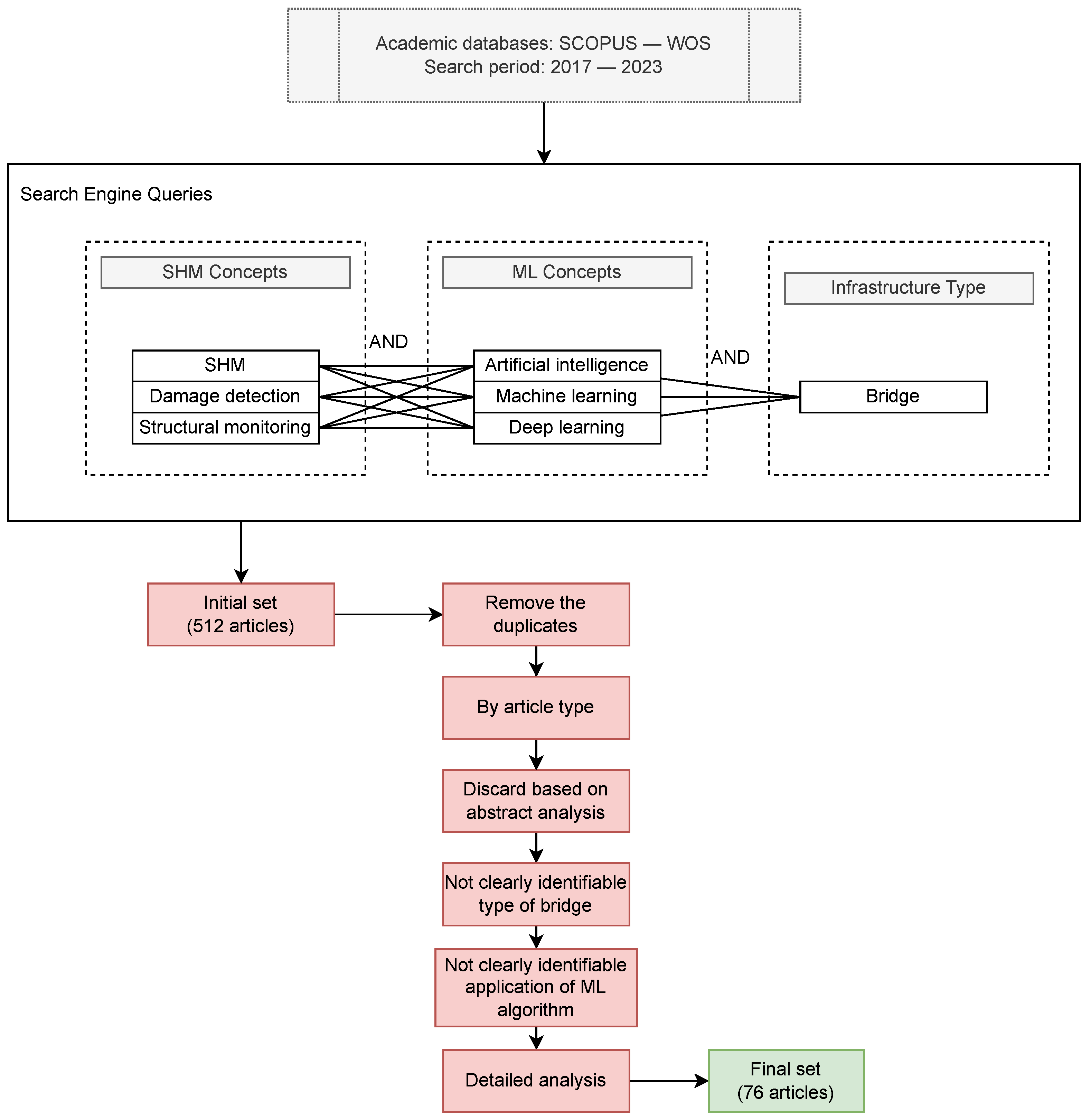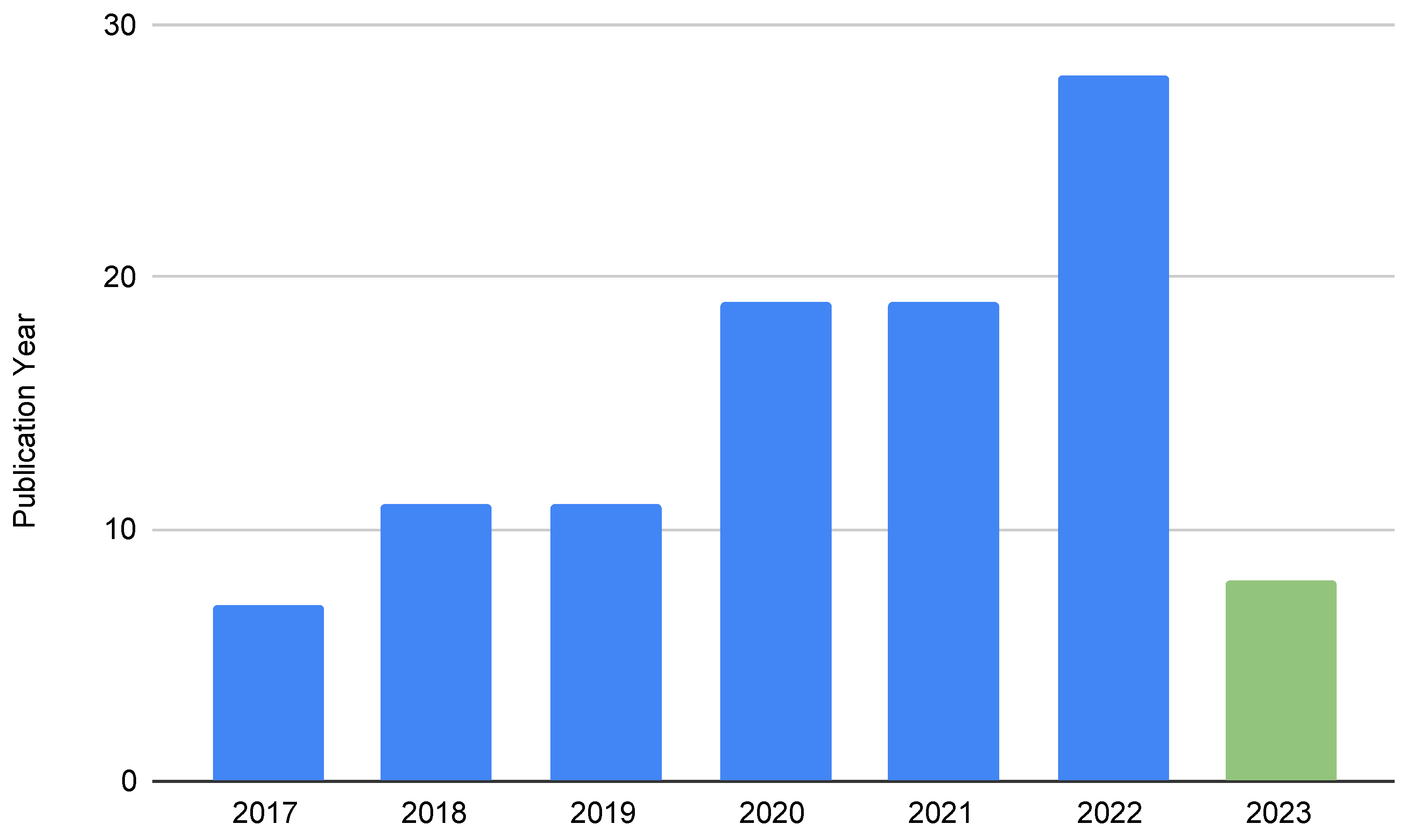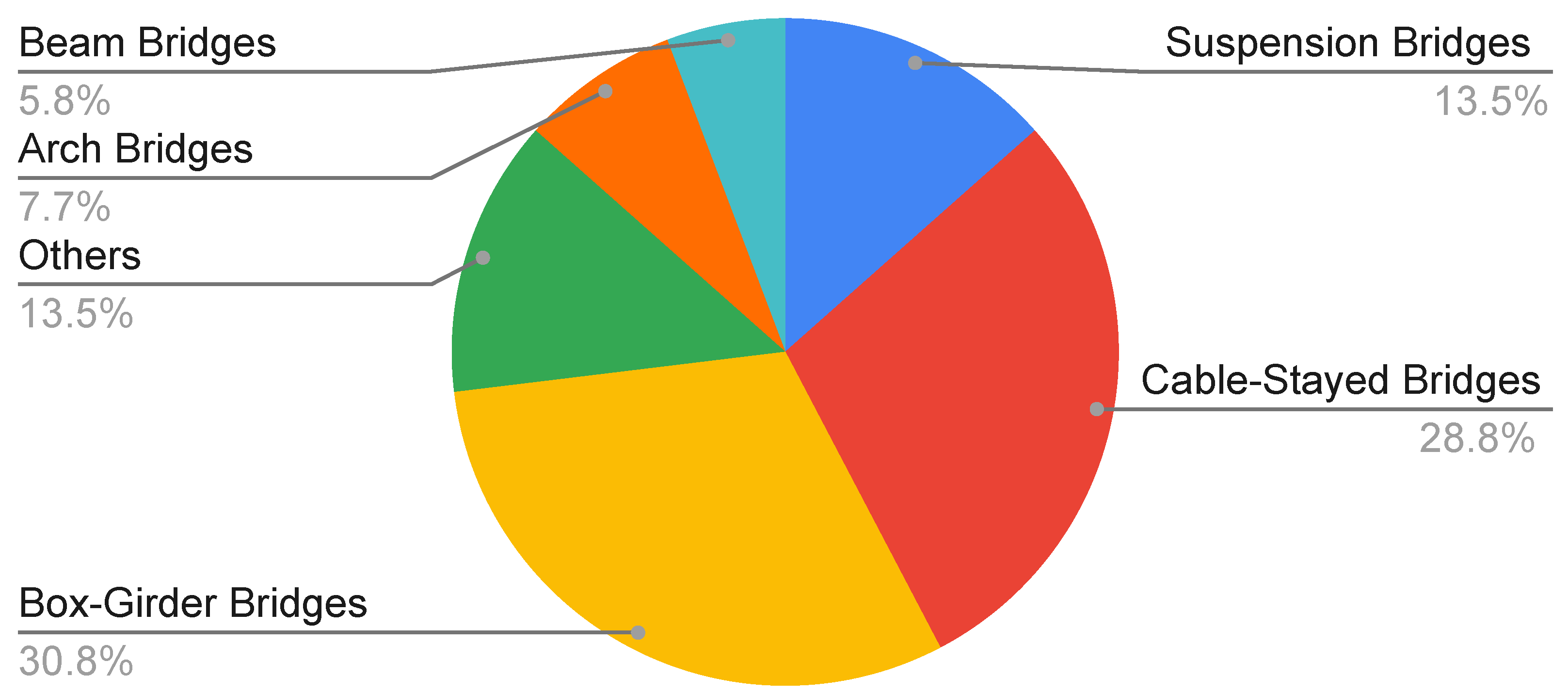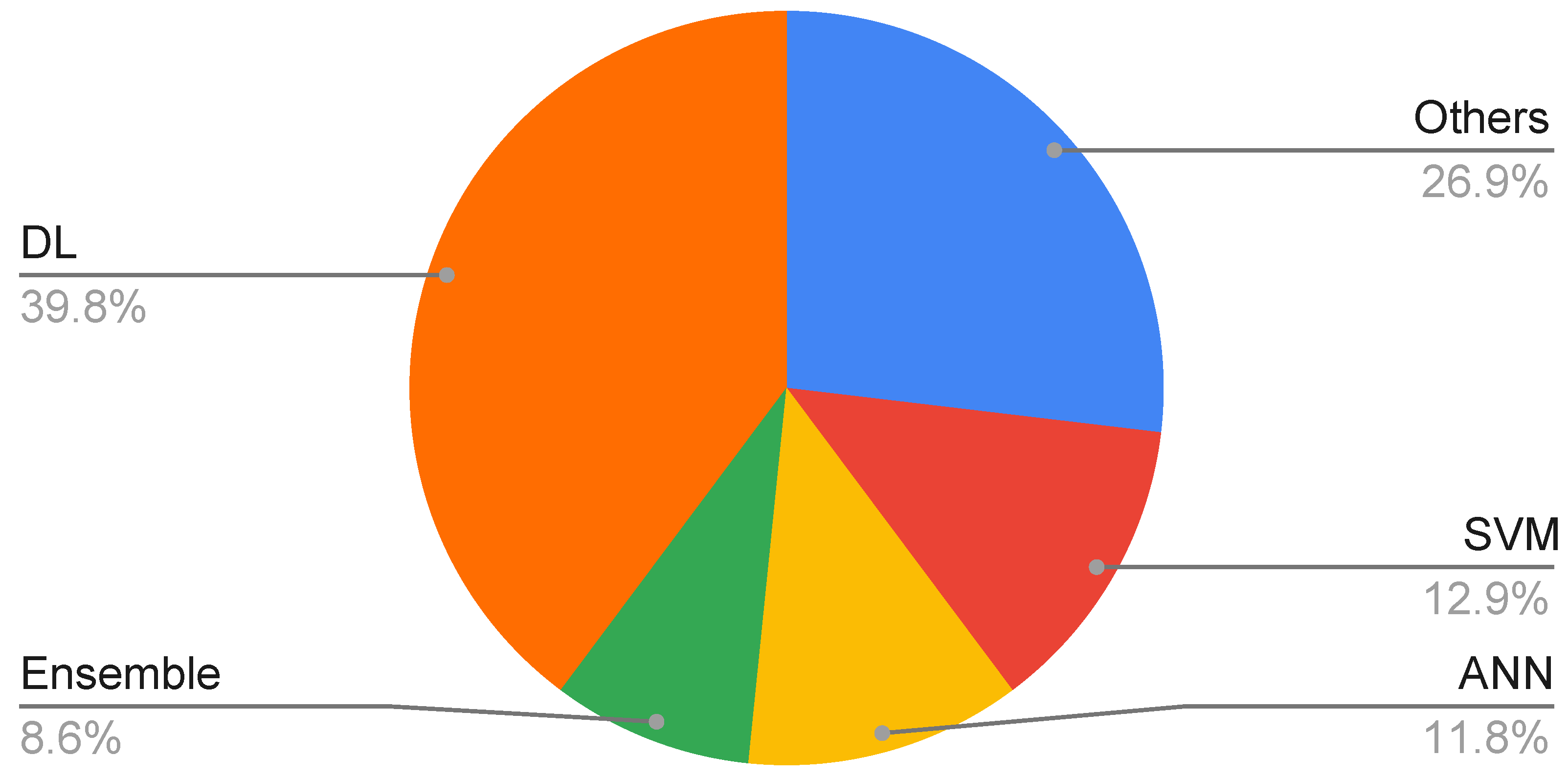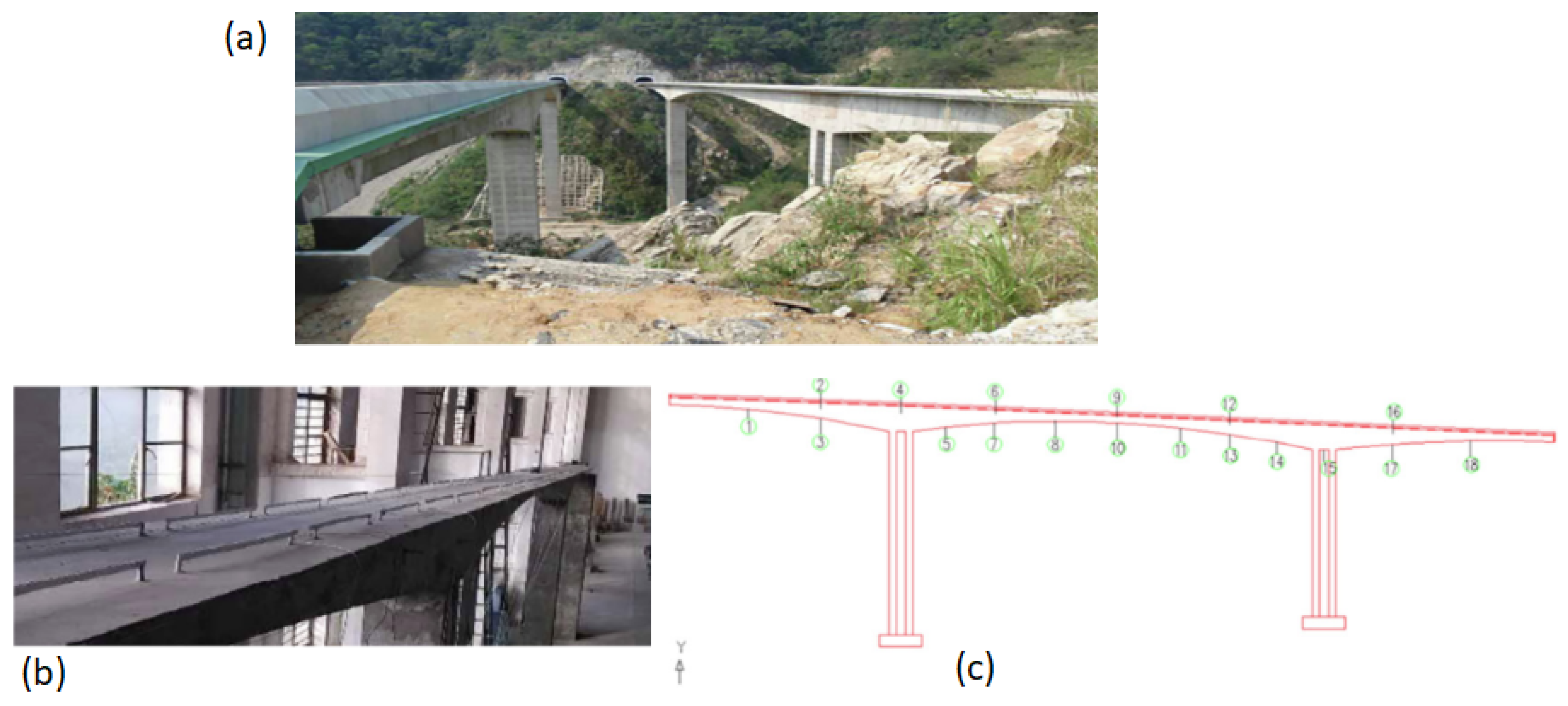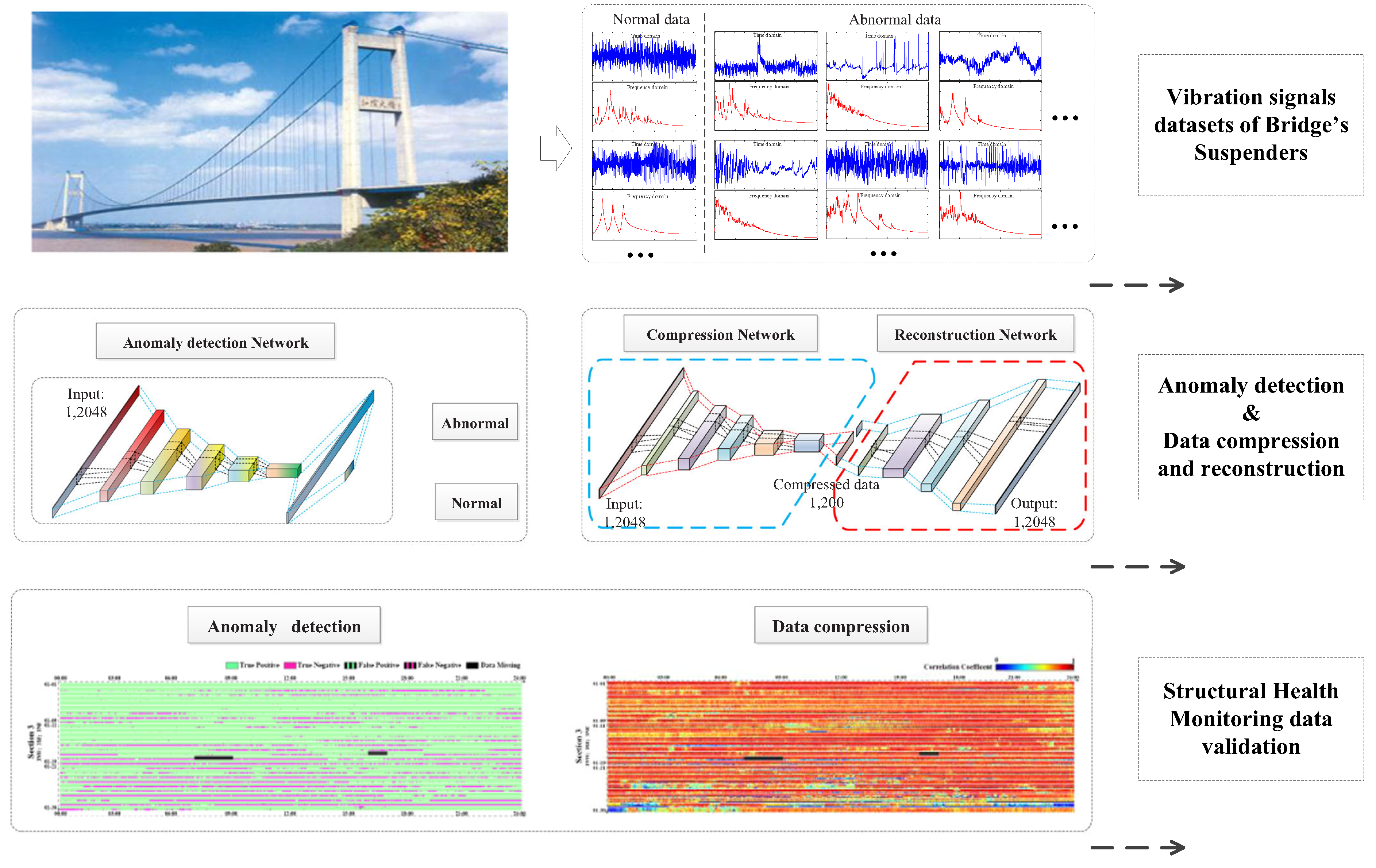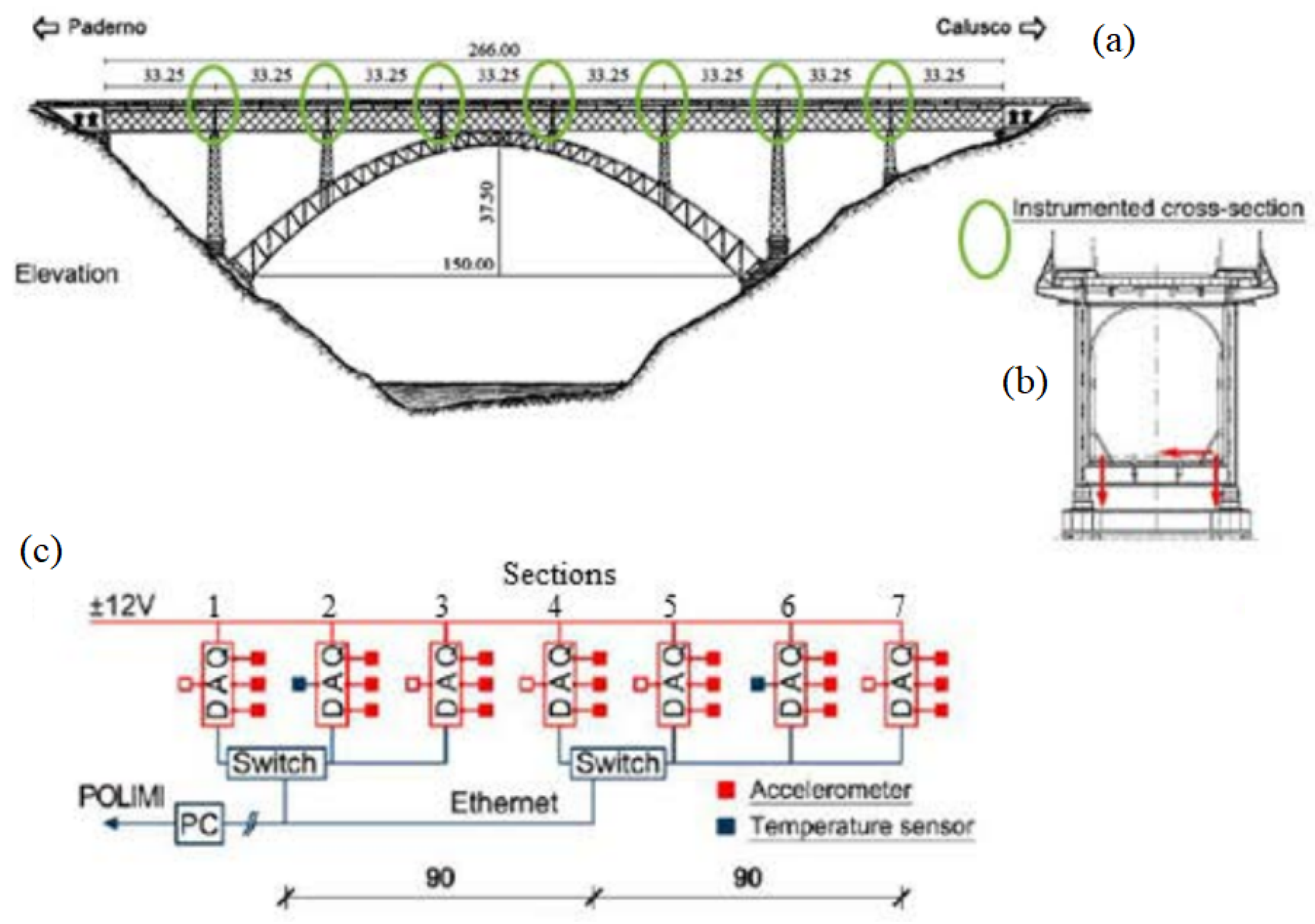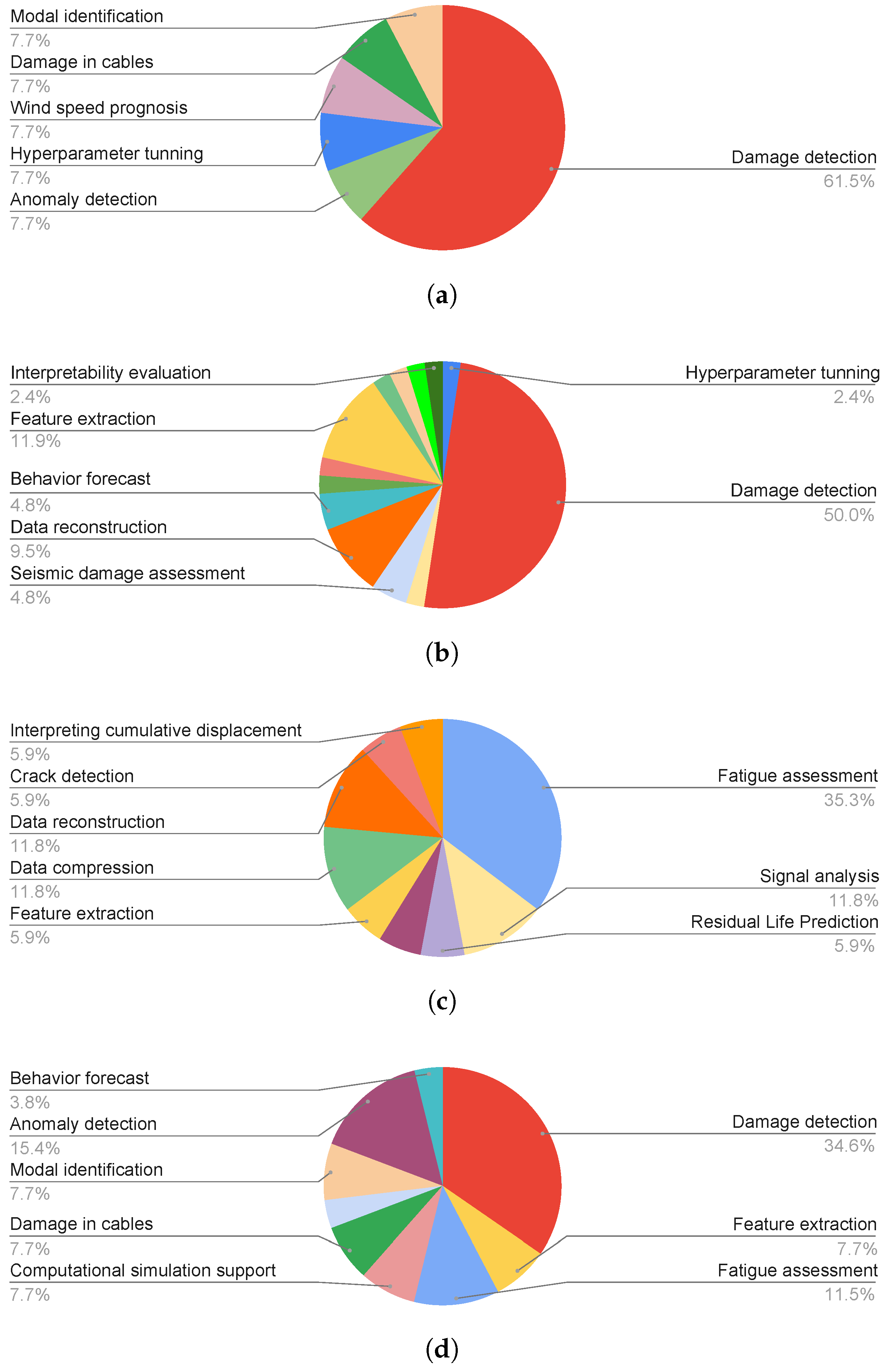The applications of ML techniques within the realm of bridge structural health monitoring are discussed in the subsequent subsections. Particular attention is paid to projects that used data collected from actual bridges and field studies. Furthermore, these applications are categorized according to the four bridge typologies most frequently investigated in the literature. A concise table that summarizes the ML technique used, the input data sources, the bridge under examination, and the intended objectives of the implementation is provided for each typology.
3.1. Box-Girder Bridges
Beam bridges and box girder bridges are two types of bridges that mainly differ in their structure and design. Single-girder bridges with a horizontal main girder span between two piers or supports. The main girder can be made of reinforced concrete, steel, wood, or other resistant material. Beam bridges are suitable for short- to medium-distance crossings, and their construction is relatively simple and economical. However, they have limited load-carrying capacity and are not suitable for long distances or heavy loads.
Box-girder bridges have a box-shaped cross-section. The cross-section of the box is composed of two side plates and a top and bottom plate that form a hollow box. Due to their hollow-box design, which provides greater rigidity and strength, box-girder bridges are suitable for spanning longer distances and carrying heavier loads than beam bridges. In addition, box-girder bridges have better fatigue resistance and can better withstand dynamic loads, such as heavy traffic. In summary, beam bridges are more suitable for short-to-medium-distance crossings with light-to-moderate loads, whereas box girder bridges are more suitable for covering longer distances and supporting heavier loads. A summary of the latest applications of ML algorithms using box-girder bridges can be found in
Table 3.
In the context of structural health monitoring (SHM) systems, ref. [
60] distinguished between modal parameter and direct signal-based approaches, with the latter categorized into time, frequency, and time–frequency domains [
61]. An innovative algorithm for assessing damage on box-girder bridge columns was introduced in the frequency domain [
31]. It employs power-spectral density to process structural responses and introduces a novel damage index using the least square distance metric. The approach was validated using a numerical model of the W180 box-girder bridge, a structure previously studied by [
62], and other similar bridges. Unlike the algorithm evaluation, a numerical model was not provided for the application. Alternatively, a method for detecting, localizing, and quantifying damage was proposed in [
28]. It combines rough set theory and naive Bayes for classification using dynamic signatures linked to modal parameters as sensitive damage features. The four-step process involves extracting modal parameters, computing dynamic signatures, localizing damage, and quantifying damage severity using the RSNB classification algorithm. Validation employed a FEM model of a 50-meter-long box-girder bridge located in Shenyang, China, comparing results with various ML techniques.
A hybrid option that blends the strengths of both methods can be considered in addition to the two main approaches to structural health monitoring (data-driven and model-driven). This approach can be addressed using model updating techniques, where data from a real structure are compared with FEM-predicted responses. Significant discrepancies between simulated and measured responses indicate structural-damage-associated changes in the bridge dynamics. The FEM must first undergo a calibration step (commonly referred to as model updating) to ensure effectiveness, in which parameters related to material properties, geometry, and loading conditions are adjusted to achieve the closest possible match with the real structure. To optimize this calibration process, computational methods, such as convolutional neural networks (CNN) [
63,
64], Bayesian models [
65], and deep reinforcement learning (DRL) [
66], have been successfully employed.
Another way to implement a hybrid approach is through data augmentation techniques (increasing the number of test cases analyzed by the algorithm by creating new cases artificially). This integration is exemplified by [
30], where data from the normal conditions of the Z-24 bridge in Sweden and simulations of a finite element model were combined. This integration aimed to detect structural damage under variable conditions, using the Gaussian Mixture Modeling (GMM) algorithm for classification. The performance of the proposed algorithm was compared using SHM system data, FEM data, and combined data sources. Additionally, the natural frequencies of the bridge served as sensitive damage features for input into the classification algorithm. It is important to note the extensive use of this dataset within this field. More details on data collection can be found in [
67], which describes the SIMCES project. Refer to [
68,
69,
70] for additional information on the bridge.
The shortage of labeled data for training supervised algorithms is a challenge in SHM [
71]. Approaches such as active learning, fuzzy labels, and semi-supervised learning have been used to overcome these limitations [
72]. A probabilistic method based on active learning was introduced in [
32] for the classification of structural damage. It adapts as new data with varying distributions arrive, actively discovering new classes. This was validated using acoustic emission [
73], Gnat aircraft datasets [
74], and the Z-24 bridge. A variation was proposed in [
51], altering the data querying based on an information criterion. An automated anomaly detection model for structural damage using modal parameters and the one-class convolutional neural network (OCCNN) algorithm on the Z-24 bridge was presented in [
37]. In [
59], an autoencoder was used to reconstruct undamaged acceleration data sequences, with macrosequences helping to establish damage thresholds.
Extreme value theory (EVT), a branch of statistics that deals with stochastic deviations, was used to statistically address data scarcity in [
75]. A previous study [
52] presented an anomaly detection method using probabilistic ML with EVT as a core component, validated on the Z-24 and Tianjin-Yonghe bridges. Comparisons were made with classical techniques, such as GMM, singular value decomposition (SVD), and principal component analysis (PCA). An unsupervised algorithm based on semiparametric extreme value (SEV) theory was proposed to tackle unknown parameter estimation challenges in [
53]. Furthermore, a method for estimating thresholds using the generalized extreme value (GEV) theory [
76], incorporating K-medoids classification and a new damage indicator to improve detection accuracy, was introduced in [
41].
Hybrid algorithms have emerged to address structural health monitoring challenges. The combination of CNNs and RNNs has been explored [
35]. Convolutional neural networks (CNNs) extract spatial relations, whereas RNNs, such as GRU, capture temporal relations. The proposed model, HCG (Hierarchical CNN and GRU framework), merges CNN and GRU for joint spatial-temporal modeling of damage detection. Validation used the TCRF Bridge dataset. Similarly, ref. [
49] sequentially combined CNN and GRU to extract the characteristics of vibration data and classify damage. Meanwhile, [
43] introduced the PCBG model, a parallel architecture of CNN and GRU (
Figure 7), which achieved robust results compared with other approaches.
Effective feature extraction improves damage detection algorithms [
77]. A two-level strategy for vibration-based damage detection was presented in [
40]. An initial identification of the modal parameters is used to estimate the natural frequencies using stochastic subspaces [
78]. Then, stacked AEs are applied to improve damage detection classifiers, particularly using a Gaussian mixture model (GMM) with expectation-maximization (EM-GMM) [
79]. This approach was compared with PCA, AANN, and KPCA. A genetic algorithm (GA) was employed for parameter optimization to address the sensitivity of the EM algorithm to parameter choice [
27], enhancing the performance of EM-GMM in distinguishing between structural states.
Furthermore, a novel architecture convolutional neural network, named the Channel-Spatial-Temporal Attention (CSTA)-based network, was proposed in [
46]. This architecture employs three sequential attention blocks to enhance the importance of selected features, while disregarding those that are deemed uninformative. Each attention mechanism weighs certain features in each of the three domains (channel, spatial, and temporal). The process begins with a squeeze-and-excitation (SE) attention mechanism, as described in [
80]. Subsequently, two new attention mechanisms are introduced for computing spatial attention (local and global attention) and temporal attention (grouped self-attention). Experiments were conducted using the TCRF dataset mentioned above (
Figure 8), and the network was compared with other architectures such as MLSTM_FCN [
81], HGC [
35], PCBG [
43], and ResNet [
82].
Common methods for extracting damage-sensitive features often operate in the frequency or time domains, with a subset focusing on the time–frequency domain [
83]. A novel model in [
54] combined Echo State Networks (ESN) for time-domain features and a Multiscale Convolutional Neural Network (MSCNN) for frequency-domain features. This model simultaneously extracts damage-sensitive features from the time–frequency domain. The model employs data augmentation to divide the sensor data into equal-length batches. A Fourier transform is applied to each batch copy to represent the data in the time and frequency domains. The proposed model demonstrated improved performance when compared with existing neural network architectures.
In contrast, ref. [
42] introduced a quefrency-domain-based feature extraction method for damage sensitivity, a well-explored approach in acoustics [
84]. The advantage of the quefrency domain is its low-dimensional representation, which enhances the speed of the damage detection algorithms. They employed PCA for cepstral coefficients to extract damage-sensitive features, to minimize the impact of external variables. Similarly, ref. [
45] combined acceleration and acoustic data in the quefrency domain for a novel approach to monitoring structural health. Their four-phase damage detection framework included data preparation, feature extraction (using cepstral coefficients), model training, testing, and validation. A transfer learning strategy incorporating vibration and acoustic data was adopted, as described in [
85]. Data normalization was highlighted due to significant frequency differences. A time delay neural network (TDNN) was recognized for shift invariance, and context modeling for damage detection [
86].
Given the challenging conditions sensors endure in bridge monitoring systems, sensor failures leading to data loss are common [
87]. Such failures can disrupt the algorithms processing the data. Techniques for reconstructing lost data using information from functional sensors are essential. Ref. [
34] presented an ML-based model that establishes relationships among environmental variables (temperature, deformation, dynamic displacement) to bridge global and local responses. This knowledge helps in data recovery. A memory-enhanced short-term LSTM network was employed to map three relationships: temperature to deformation, vehicle-induced deformation to dynamic displacement, and dynamic displacement to vehicle-induced deformation.
Additionally, this issue can be split into two scenarios: recreating data from a faulty sensor using similar sensors (STS) and attempting to recreate data using different sensors (DTS), requiring inter-domain relationship extraction. Various studies have tackled this challenge using different approaches. These include combining CNN with GAN [
38], employing GAN and LSTM separately for STS and DTS cases [
50], and using a BiLSTM [
58]. The proposals were validated using different datasets, such as the Fuchang and Lieshihe bridges in China and the Z-24 box-girder bridge in Switzerland.
However, data loss can also result from factors such as network congestion due to the high dimensionality of sensor data. This aspect remains relatively unexplored in the SHM context. To address this, ref. [
48] introduced a three-step damage detection approach involving data compression and recovery, modal parameter identification, and final classification. A model-assisted rakes-based compressed sensing technique (MRAK-CS) was employed in the first phase to alleviate network congestion [
88]. Two neural network architectures were compared: a one-class classifier neural network (OCCNN) and an auto-associative neural network (AANN).
With the advancement of computer vision techniques, several crack and corrosion detection approaches based on images captured directly from the structure have emerged [
89]. For example, ref. [
90] proposed an efficient lightweight encoder–decoder network that integrates attention mechanisms and residual blocks to detect pavement cracks. Similarly, ref. [
91] introduced a framework for designing optimized neural network architectures for real-time crack detection. Moreover, ref. [
92] presented a novel model that enhances the well-known YOLO computer vision algorithm by incorporating transformer-based components, achieving effective crack detection in the concrete of various bridges.
In addition, two studies focusing on using images as input for the ML algorithm, validated with images of the beam of box-girder bridges, are worth noting [
39,
55]. The first study tackled the challenge of working with images captured by unmanned aerial vehicles (UAVs). External factors, such as vibration, wind, and UAV movement, often affect these images. Techniques are employed to evaluate and enhance image quality, followed by inputting the processed images into a CNN model for damage classification. Specifically, the CNN model of [
93] was used for damage detection using preprocessed images obtained through the mentioned algorithms, leading to better damage detection outcomes.
Conversely, corrosion can cause performance degradation, as it responds to operational and environmental loads, and over time, it can cause more severe failures [
94]. Thus, in [
55], a hierarchical CNN-based classifier was developed for detecting corrosion in images. A public dataset of UAV images captured in Australia was used to validate the proposed method. Moreover, the Bolte Bridge and the Victoria Sky Rail were selected for evaluation.
In the aftermath of seismic events, local authorities commonly conduct inspections to determine the safety of civil structures such as bridges for public use. Rapid assessment of structural integrity at a regional scale poses a significant challenge [
95]. A rapid methodology for evaluating post-seismic structural damage was presented in [
33]. This approach employs a set of 21 parameters that incorporate geometric, material-related features [
96], and the characteristics of seismic motions [
97]. Various ML algorithms were evaluated, including discriminant analysis, k-nearest neighbors (KNN), Naive Bayes, Decision Tree, and Random Forest. In particular, Random Forest achieved the highest accuracy. In a separate work, ref. [
56] introduced a novel data-driven strategy to regionally assess the condition of reinforced concrete bridges using machine learning. The inputs encompassed the physical, geometric, and material parameters related to the bridges, combined with seismic motion data from [
97]. Six ML techniques were evaluated, with XGBoost emerging as the optimal choice after hyperparameter optimization.
Typically, traditional bridge inspection methods involve visual evaluations and dynamic and static load tests [
98]. Although the first two methods are relatively affordable, they may not capture all of the relevant structural health aspects. In contrast, static load tests can address these limitations, but their expense poses a challenge. To address this issue, ref. [
36] employed the Kriging spatial inference technique to predict the results of costly static load tests. The process involves developing an initial finite element model of the structure, which is refined using dynamic load test results to better match the actual structure. Then, this enhanced model is used to predict the results of the static load test.
Vibration control systems (VCSs) play a vital role in bridges, with four main types: passive, active, semi-active, and hybrid. Tuned mass dampers (TMDs) are a common passive solution for managing wind-induced vibrations in bridges [
99]. Although the optimal TMD design has been well studied, few studies have assessed its effectiveness. To address this, ref. [
47] introduced a machine-learning-based method to evaluate the efficacy of TMD. Seven algorithms were compared: Random Forest, ANN, DT, KNN, GBRT, AdaBoost, and XGB. Random Forest excelled in predicting TMD vibrations using wind and temperature-related input features. These studies stand out for their machine learning approaches for predicting bridge or component performance, contrasting with previous applications focused on damage detection or monitoring.
Deflection, a critical metric in bridge assessment [
100], can be negatively influenced by the interplay of operational and environmental factors, reducing the precision of the safety assessment methods relying on it. In response, ref. [
29] devised an integrated machine learning algorithm based on ensemble empirical mode decomposition (EEMD), Principal Component Analysis (PCA), and Independent Component Analysis (ICA). The algorithm separates the observed signals from the individual deflection components. The approach was theoretically validated using a Hanxi bridge finite element model and a liquid-level sensing system installed on the same bridge in 2015 (
Figure 9).
However, a notable challenge with numerous ML models lies in their opaqueness, often operating as “black-box” systems that yield outcomes based on inputs, without unveiling the inherent data relationships learned. Addressing this concern, ref. [
57] underscored the potential for better decision-making in preventive maintenance strategies for structures if the predictions from these models could be scrutinized and understood. Their study investigated three model interpretability techniques: Partial Dependence Plot (PDP), Accumulated Local Effects (ALE), and Shapley Additive Explanations (SHAP). These methods were rigorously explored within a seismic engineering context, and their applicability was scrutinized in two case studies: one focused on component-level damage estimation (reinforced concrete walls) and the other on regional damage assessment for inclined bridges in California.
Furthermore, an innovative mobile application for structural health monitoring and damage detection was introduced that embraced advances in smart sensing technology [
44]. The app exploits the accelerometers inherent within mobile devices to capture structural accelerations, discern modal parameters, and use the Mahalanobis distance to perform unsupervised structural damage detection. The experimentation began by assessing the app’s efficacy in estimating natural frequencies. Performance comparisons were conducted between the app and other sensor devices, including piezoelectric accelerometers, in controlled laboratory settings and real bridge environments. Remarkably, the study’s findings underscore the application’s remarkable accuracy and substantial cost advantage compared with a comprehensive instrumentation system.
3.2. Suspension Bridges
Suspension bridges are engineering structures consisting of two support towers and a main cable that stretches between them. Secondary cables, also known as stay cables, extend from the main cable to the bridge deck, where the load is supported. Suspension bridges are well suited for crossing large bodies of water or deep valleys because they can span much longer distances than other types of bridges. They can also support heavy loads such as trucks and buses. Compared with other types of bridges, suspension bridges have several distinct characteristics. For example, they are considerably thinner and lighter than beam or arch bridges, making them more elegant and aesthetically appealing. They can also be more resistant to certain types of forces, such as high winds, due to their aerodynamic design. However, suspension bridges are more expensive to construct than other types of bridges, due to their design and construction complexity. Suspension bridges currently account for approximately 10% of the world’s longest and most iconic bridges. Some notable examples include the Golden Gate Bridge in San Francisco, the Akashi Kaikyo Bridge in Japan, and the Hangzhou Bay Bridge in China. Although suspension bridges represent a small portion of the total number of bridges in the world, they have been important to civil engineering and remain a popular choice for bridge construction projects over long distances.
Table 4 provides a summary of the latest applications of ML algorithms using suspension bridges.
Diverse ML applications focusing on fatigue assessment for suspension bridge analysis have been proposed. To estimate cable tension, ref. [
105] employed video processing and principal component analysis (PCA), integrating cable vibration concepts for stress determination. An innovative fatigue estimation method for stays or hangers and using support vector machines (SVM) was introduced to model daily fatigue damage from traffic loading parameters [
111]. In [
113], a three-step process was presented to assess fatigue by classifying the types of trains that cross a bridge using an SVM for high prediction accuracy. For hot spot analysis in steel beams, ref. [
101] employed SVR to replace FEM updates, whereas [
112] employed GBRT with monitored parameters for fatigue prediction. The influence of train load on suspension bridge fatigue was emphasized and validated using data from the SHM system of the 25 de Abril Bridge (see [
116] for more details).
Similarly, ref. [
115] presented an approach to quantitatively interpret the effects of the load on the cumulative displacement, which is vital for assessing the service life of a bridge. This method analyzed correlations between environmental loads, traffic, and bridge response using Shapley additive explanations (SHAP) and random forest (RF) data from the April 25th Bridge. Train loading was the most influential factor in the cumulative displacement. Wind and temperature had a minor impact on a structure’s failure. A comparative study of logic data analysis (LAD), artificial neural networks (ANN), and proportional hazard models (PHM) was conducted [
103]. NASA Turbofan data and Nova Scotia bridge SHM data were employed. Although the LAD and ANN models excelled in accuracy, PHM was preferred for scarce or non-representative data. To identify fatigue-induced cracks in welded steel bridge joints, a computer vision-based strategy was introduced [
110]. This method detects and segments cracks using IoT image capture, panoramic generation, and convolutional networks, and its efficacy was validated on a real 20-year-old steel suspension bridge.
Numerous studies have focused on data analysis, processing, and compression, as exemplified by [
102]. Their study empirically validated the Bayesian dynamic models for SHM to separate the measured structural responses into traffic, temperature, and other components. This decomposition allowed each component to be specifically analyzed, thereby improving the results. The work verified the Bayesian model by considering Tamar Bridge data (the system monitoring and data processing details can be found in [
117,
118,
119]). Modal properties are vital as damage indicators reflecting material changes. In [
107], Jang and Smyth explored the impact of temperature on modal parameters, to distinguish damage-induced changes from environmental effects, enhancing the efficacy of the SHM system. Their study evaluated three techniques, including an artificial neural network, to replicate the effects of temperature on natural frequencies.
A novel approach, introduced in [
104], adapted deep principal component analysis (DPCA) to capture nonlinear relationships within structural responses, improving the performance of normalization and damage detection. In [
108], a one-dimensional CNN was combined with an autoencoder to compress and reconstruct SHM data (
Figure 10). The method achieved accurate anomaly identification and minimal reconstruction errors at a compression rate of 10%. A deep-learning-based framework, DL-AR-ATT, integrating an autoregressive model and an attention mechanism for the precise reconstruction of correlated structural responses was proposed in [
114]. The approach outperformed hybrid models based on one-dimensional CNNs. Furthermore, the reconstruction of compressive sensing data using neural networks was addressed in [
109]. The proposed approach was validated through experiments involving sine waves and wireless data from the Xiamen Haicang Bridge, demonstrating a highly accurate reconstruction. In particular, network parameters offered transparent mapping, ensuring robust interpretability for the neural network used in the compressive-sensing data reconstruction.
3.3. Cable-Stayed Bridges
Cable-stayed bridges are engineering structures consisting of one or more support masts and suspension cables that extend from the mast to the bridge deck. Unlike suspension bridges, cable-stayed bridges do not have a main cable extending between the support towers. Instead, suspension cables support the bridge deck directly from the mast. Cable-stayed bridges can span long distances and are suitable for crossing large bodies of water or deep valleys. In addition, they can support heavy loads and are a popular choice for vehicular traffic bridge construction.
Cable-stayed bridges have several distinct characteristics compared with other types of bridges. For example, their design is simpler and requires fewer construction materials than suspension or arch bridges. Furthermore, they are easier to maintain than the main cables on suspension bridges because they are easier to inspect and repair. However, cable-stayed bridges may be less resistant to certain types of forces, such as high winds, because they are not as aerodynamic as suspension bridges. Cable-stayed bridges currently represent about 20% of the world’s longest and most iconic bridges. Some notable examples include the Biscayne Bay Bridge in Spain, the Peace Bridge in Thailand, and the Millennium Bridge in the United Kingdom. A detailed summary of the latest advances in the application of different ML algorithms, using cable-stayed bridges as a case study, can be found in
Table 5.
A CNN-based method was employed in [
129] to estimate cable tension from temperature fluctuations using data from the Suramadu Bridge in Indonesia. Comparison with other techniques (ANN and linear regression) confirmed the superior cable force estimation capability of the proposed CNN. Furthermore, a probabilistic approach was presented to assess the accumulation of fatigue damage in coastal bridge welds [
121]. Stochastic load modeling, followed by finite element analysis aided by uniform design sampling (UDS) and Support Vector Regression (SVR), was employed to manage the computational complexity. The approach is consistent with [
124], who used SVR and Latin Hypercubes Sampling (LHS) to replace resource-intensive FEM updates. Experiments using a cable-stayed bridge model revealed the impact of wind on beam displacements and the influence of waves on the shear response of the foundation base.
Regarding cable-stayed bridge cable damage detection, ref. [
122] employed a finite element model (FEM) of a real Yangtze-River-spanning bridge to evaluate the reliability of the cable system against fatigue and atmospheric corrosion. Using adaptive support vector regression (ASVR), nonlinear response functions of key components were approximated for cable rupture prediction. The reliability assessment employed the
-unzipping method, which incorporates an event tree for estimations of varied structural reliability. A hybrid LSTM-CNN architecture for cable damage detection was proposed using a different approach in [
128]. The input data included individually measured cable forces and force ratios between cable pairs. Combining these scenarios improved the identification of probable damaged cables, contributing to the achievement of first-place in the IPC-SHM 2020 competition.
Various machine learning techniques are used in SHM for cable-stayed bridges, often using ANNs to detect structural damage via vibration data or other sources. Four deep learning algorithms (Multilayer Perceptron, LSTM, 1D, and 2D CNN) were evaluated for structural damage detection from raw time series data [
134]. The distinction between 1D and 2D CNNs lies in the input format: raw signals vs. time–frequency data derived from short-time Fourier transform (STFT). The validation used four case studies, including data from the Vasco da Gama Bridge instrumentation system in Lisbon, Portugal.
In [
131,
132], the problem of the limited availability of structural data was addressed using two GAN variants for unsupervised identification, quantification, and localization of damage. A deep convolutional GAN (DCGAN) detected and quantifies damage, whereas a conditional GAN localized it. Similarly, in [
132], Convolutional Autoencoders (CAE) identified and quantified damage using vibration signals, without damage data. To combat the scarcity of training data, transfer learning was used in [
85]. Two CNN components, “source domain” and “target domain”, leveraged numerical model and bridge data, respectively, yielding strong results. In contrast, a previous study [
125] used deflection data from a cable-stayed bridge scaled for structural damage detection using a deep CNN. This study notably outperformed classical ML algorithms and stands as one of the few that used deflection data for analysis.
Ref. [
120] introduced an innovative SHM approach using SVM with radial kernels in cable-stayed bridges. Advanced feature extraction methods, including wavelet transform, Hilbert–Huang Transform, and Teager–Huang Transform. The effectiveness of the method was evaluated through a numerical simulation using the Manavgat cable-stayed bridge, with wavelet transform showing robustness to noise, while THH and THT demonstrated sensitivity to damage. In another study, ref. [
138] explored the behavior of a cable-stayed bridge in high-speed winds, devising an early warning model based on wind variables. The dynamic response of the bridge was predicted using wind turbulence data and random forest vibration amplitude forecasting. This approach was validated on the Sutong cable-stayed bridge, generating early warning alerts using a vibration indicator and threshold.
In a different approach to modal identification from data collected on cable-stayed bridges, a method that employs a customized deep neural network (DNN) for modal shape identification was presented [
133]. Using raw vibration data from a real cable-stayed bridge, their approach demonstrated a performance comparable to that of various advanced techniques for identifying modal parameters, underscoring its effectiveness. A time-efficient procedure was proposed for identifying modal parameters using ML [
139]. Their multitask deep neural network efficiently extracts independent modes from structural dynamic responses, yielding modal frequencies and damping coefficients. The proposed method provides accurate modal parameter identification, while significantly reducing processing times compared with existing techniques.
A novel model for damage detection using unlabeled data and DL techniques was introduced [
123]. Their approach integrates feature extraction through an autoregressive (AR) model, dimensionality reduction using a deep autoencoder, and anomaly detection via the Mahalanobis distance. The data were obtained from the structural health monitoring (SHM) system of the Tianjin-Yonghe cable-stayed bridge (
Figure 11) in China (see [
140] for more information). The study addressed two key SHM challenges: (1) the high dimensionality of input data, which can impede damage detection algorithms, and (2) the scarcity of labeled structural damage data, which is often required for supervised methods. Despite these challenges, the results highlighted the efficacy of the proposed approach in detecting early damage.
Finally, contemporary DL techniques were applied in [
130]. This study addressed the gap that many classification algorithms focus on single-type time series data rather than leveraging combined multivariate sensor data. The Functional Echo State Network (FESN), a variant of Recurrent Neural Networks (RNNs), was introduced to bridge this gap. FESNs, part of the Echo State Network (ESN) family, have broad applications in engineering, telecommunications, and various fields involving signal processing. In a pioneering approach, this neural network architecture was augmented with the Particle Swarm Optimization (PSO) algorithm to optimize hyperparameters and enhance accuracy, yielding rates exceeding 97%. The study is a rare example of the integration of metaheuristics into a framework.
Several studies have introduced techniques using the IPC-SHM dataset in the context of anomaly detection due to sensor failures in SHM systems [
127,
135,
136,
137]. A method that combines “Shapelet Transform” with Random Forest for anomaly classification was proposed in [
127]. Shapelet Transform uses time series data shape for representation, finding Shapelets that best match the data to create a new feature space. Despite automatic anomaly detection, challenges related to dataset specifics were noted, suggesting potential solutions through preprocessing.
In [
135], GANs and AEs were used to transform sensor data into Gramian Angular Field images using advanced image processing. With an average accuracy of 99% for anomaly differentiation, the proposed approach demonstrated high accuracy and robustness. Moreover, various NN models, such as ANN, CNN-based spectrogram, and temporal history models, and an image-based time–frequency hybrid CNN (GoogLeNet), have been explored [
136]. GoogLeNet performed exceptionally well; however, confusion due to class similarity was acknowledged. To address this, an ensemble model that combines the four methods was introduced for improved results. Finally, a model comprising three modules was proposed in [
137]. The first transforms acceleration signals into a 3-channel space using time, frequency (via Fourier transform), and Gramian Angular Field representations. GANomaly is employed for feature extraction in imbalanced SHM data. Finally, ResNet-18 is used for anomaly classification.
3.4. Arch Bridges
Arch bridges are characterized by a curved arch structure that spans from one end of the bridge to the other. Arch bridges are capable of supporting heavy loads due to their arch design, which distributes the load of the bridge evenly across its structure. Arch bridges can be constructed from stone, brick, reinforced concrete, or steel. Unlike suspension and suspension bridges, arch bridges do not require suspension cables or support towers to hold the bridge deck in place, allowing for a simpler and more economical construction. Another distinguishing feature of arch bridges is their elegant and often ornate appearance. Arches can be single or multiple curves and decorated with sculptures, mosaics, reliefs, and other decorative elements. Arch bridges can be built at various heights and lengths, making them suitable for various settings and uses.
As shown in
Table 6, the most commonly used bridge for validating works that used data from an arch bridge was the Sydney Harbour Bridge, described above, although these studies were condensed between 2017 and 2018. In turn, a recurrent use of the KMeans clustering technique can also be seen; although, as will be seen below, they were used for different reasons.
Although SVMs and the KMeans clustering algorithm have been extensively used in an arch bridge SHM context, they have also been applied in different approaches. An SVM with a Gaussian kernel was employed in [
141], where a performance problem due to the sensitivity of the
parameter of the Gaussian kernel was highlighted. To address this issue, a new algorithm called Appropriate Distance to Enclosing Surface (ADES) was proposed, which allows adaptive tuning of the Gaussian model parameter. Data obtained from the Sydney Harbour Bridge were used to validate the damage detection capabilities and parameter tuning of this method, in addition to various other datasets. The proposed algorithm can identify suitable sigma parameter values when data are high-dimensional.
Simultaneously, ref. [
145] extended this research by including additional experiments. In [
143], a data tensor decomposition (TD) algorithm was proposed that allows a machine learning algorithm to process the temporal, spatial, and feature attributes of data simultaneously. In addition, SVM is employed to detect and evaluate the severity of the damage progress, and KMeans is employed to locate the structural damage by exploiting the performed tensor decomposition. The proposed method was validated using structural data collected from the Sydney Harbour Bridge, and the results included the correct detection of damage and the estimation of different severity levels, as well as the detection of spatial anomalies associated with sensor and instrumentation problems.
In [
144], the authors proposed a novel approach based on spectral moments (SM). These moments contain information on various frequencies and are useful for structural damage detection. In addition, a variant of the KMeans algorithm was used to group the results and determine which bridge arches showed anomalous responses. The method was validated in two stages. In the first stage, data from the dynamic responses of bridge arches with known problems were input, and the method was able to correctly identify them. In the second stage, the amount of data from different arches was expanded, and the arches identified as damaged by the model were found to have some type of unknown structural damage during testing through extensive investigation and evaluation.
Moreover, a new multistage clustering algorithm for automatic operational modal analysis (AOMA) was presented in [
150], which aims to detect and evaluate structural damage. This method was applied to a scale model of a historic masonry-built arch bridge in a laboratory environment. Operational modal analysis (OMA) is an output-only technique that uses modal parameters as features and damage indicators. The proposed algorithm includes a modal identification component based on clustering algorithms, particularly the KMeans algorithm. The feasibility of applying the proposed algorithm in civil structures was demonstrated through experimental validation, although the focus of the work was on masonry-built arch bridges.
Finally, a model designed for cable damage detection using the Jiangnan Arch Bridge as a case study was presented in [
149]. However, a finite element model of the structure was employed to validate the model. The model aims to investigate the limits of cable damage levels due to fire and corrosion effects. Several machine learning techniques, including a backpropagation neural network (BPNN), a radial basis function neural network (RBFNN), and an adaptation of the support vector machine using least squares (LS-SVM), were tested. Among the obtained results, LS-SVM achieved a higher accuracy in predicting cable damage under the combined effects of fire and corrosion.
Techniques such as artificial neural networks (ANN), and others based on the Gaussian Process (GP) and GMM, have been reported. An ANN was used in [
146] to predict the acceleration of an undamaged structure (a scale model of an arch bridge in a laboratory). After establishing a healthy reference state, damage-sensitive features were identified by calculating the root mean square error between the actual measured data and those predicted by the ANN. Outliers were used as possible indicators of damage. In addition, these outliers were detected using two methods: the Kolmogorov–Smirnov test and the Mahalanobis distance. The results showed that the Mahalanobis distance was more effective in detecting gradual damage than the Kolmogorov–Smirnov test was for identifying small isolated damages.
Following an approach similar to [
142], the authors detected and located damage to the historic San Michele railway bridge in northern Italy (
Figure 12) using a four-step method that used data such as ambient temperature and dynamic responses of the bridge deck measured during traffic. The first step of the method involved obtaining reference data corresponding to the optimal state of the bridge for use in training and data on the current condition. Then, preprocessing was performed to extract the characteristics of the trains that cross the bridge. In the third stage, a neural network and a GP model were trained for each installed accelerometer. Finally, in the last stage, the acceleration of each sensor was predicted, and the bridge was damaged if the difference from the actual responses exceeded a predefined threshold.
Furthermore, data obtained from the structural health monitoring system (specifically, wind records) installed on the Jiubao Bridge in China were used by [
147] to develop an emulator model based on a Bayesian approach and a GP, to perform a probabilistic prediction of wind speed. This variable is of great importance, because it can influence a structure’s dynamic response and act as an external stress factor, independently of operational variables. The Bayesian emulator used various covariance functions, such as the squared-exponential (SE), Matern (MA), periodic (PE), and composite functions. These functions were selected because they were sensitive parameters of the process and could provide accurate results. Moreover, a novel approach to SHM, known as population-based structural health monitoring (PBSHM), arose from an issue existing in most data-driven SHM systems: these systems are typically constrained by data from a limited number of structural health states, restricting their ability to detect new types of damage.
Recognizing this limitation, PBSHM expands a labeled health dataset by considering the population structure. This approach enhances the likelihood of having more labeled information available, thereby increasing the diagnostic potential of new structural health states [
151]. In light of this, ref. [
148] proposed a new method based on the domain-adapted Gaussian mixture model (DA-GMM), which performs inference through a linear mapping that transforms the target structure data into a GMM inferred from data from another structure. Three case studies were examined to validate the model, one of which corresponded to a heterogeneous population of bridges. In the case, data from the Z-24 (box girder bridge) and the KW51 (arch bridge) were used as part of the population.
